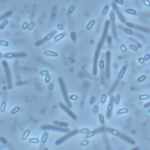Link to Pubmed [PMID] – 37214349
Link to DOI – 10.1016/j.bioflm.2023.100125
Biofilm 2023 Dec; 5(): 100125
Clostridioides difficile infection associated to gut microbiome dysbiosis is the leading cause for nosocomial diarrhea. The ability of C. difficile to form biofilms has been progressively linked to its pathogenesis as well as its persistence in the gut. Although C. difficile has been reported to form biofilms in an increasing number of conditions, little is known about how these biofilms are formed in the gut and what factors may trigger their formation. Here we report that succinate, a metabolite abundantly produced by the dysbiotic gut microbiota, induces in vitro biofilm formation of C. difficile strains. We characterized the morphology and spatial composition of succinate-induced biofilms, and compared to non-induced or deoxycholate (DCA) induced biofilms. Biofilms induced by succinate are significantly thicker, structurally more complex, and poorer in proteins and exopolysaccharides (EPS). We then applied transcriptomics and genetics to characterize the early stages of succinate-induced biofilm formation and we showed that succinate-induced biofilm results from major metabolic shifts and cell-wall composition changes. Similar to DCA-induced biofilms, biofilms induced by succinate depend on the presence of a rapidly metabolized sugar. Finally, although succinate can be consumed by the bacteria, we found that the extracellular succinate is in fact responsible for the induction of biofilm formation through complex regulation involving global metabolic regulators and the osmotic stress response. Thus, our work suggests that as a gut signal, succinate may drive biofilm formation and help persistence of C. difficile in the gut, increasing the risk of relapse.

